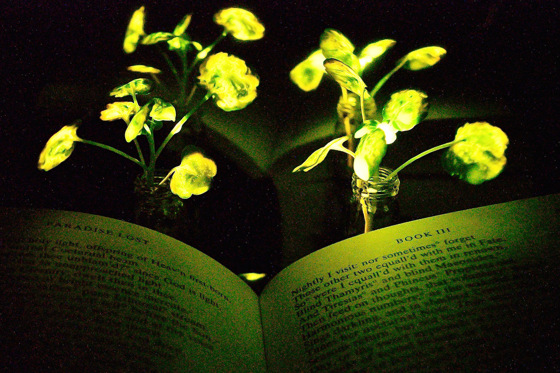Imagine a world in which trees light up as the sun sets and houseplants glow like lamps. If new research pans out, that fanciful vision could become a reality — and lend new meaning to the term “green energy.”
A team of scientists at MIT has found a way to give plants the ability to produce light. Though the research is preliminary, the researchers believe that bioluminescent plants may someday light our streets, parks, and even our homes.
The benefits of glow-in-the-dark plants are pretty obvious.
“Plants are made of carbon dioxide and consume carbon dioxide, so they are doubly carbon negative,” says Dr. Michael Strano, a professor of chemical engineering at the university and the leader of the research. There’s no need for a source of electricity — and if the plants die, they can simply be composted.
A new approach
This isn’t the first effort aimed at making bioluminescent plants. In 2010 scientists at Stony Brook University used genetic engineering techniques to produce a glowing tobacco plant. But the effort to commercialize that work faltered as a result of difficulties associated with producing the plants on a large scale and concerns over the safety of gene modification.
Strano’s team has taken a different approach. Rather than tinker with DNA, the researchers dip plants into a solution containing specially engineered nanoparticles. Each particle carries ingredients for a chemical reaction that, in combination with fuel derived from sugar inside the plant’s cells, produces light.
Using this technique, Strano has gotten watercress, kale, spinach, and arugula to glow. The light is only as bright as a nightlight. But once the chemical reaction begins, it persists for up to three and a half hours.
Strano thinks he can do better. He’s already found that by tweaking the nanoparticles, it's possible to extend the brightness and duration of the light.
He also suspects he could add molecules sensitive to sunlight that would delay the chemical reaction until the plant is in darkness. For the moment, this ever-glowing greenery would be a better choice for an office than a bedroom, where you sometimes want darkness.
Once the nanoparticle process is perfected, Strano’s team may be able to apply it to multiple plants at once simply by spraying their leaves. In principle, the technique should work for any plant.
Mood vs. task lighting
Sounds great. But what do other experts make of the research?
“I think it’s very cool,” says Dr. Mark Rea, a professor at the Lighting Research center at Rensselaer Polytechnic Institute in Troy, New York.
But while Rea can imagine the use of light-up plants for decorative purposes, he’s dubious that they’ll prove useful for task lighting. “I don’t think it’s going to displace LEDs any time soon,” he says, adding that the light is just too dim.
Strano acknowledges that the light from one plant can't compete with a task light. But he believes clusters of plants will be useful as ambient low-intensity lighting. He's teamed up with Sheila Kennedy of MIT’s architecture department to develop ways of integrating plant-based lighting into buildings and outdoor spaces.
Strano and Kennedy envision rooms where multiple plants grow while also giving off gentle mood lighting. More ambitiously, Strano believes that within the next three years they’ll have designed a space with enough bright plants to give off light to read by.
Stay tuned.

